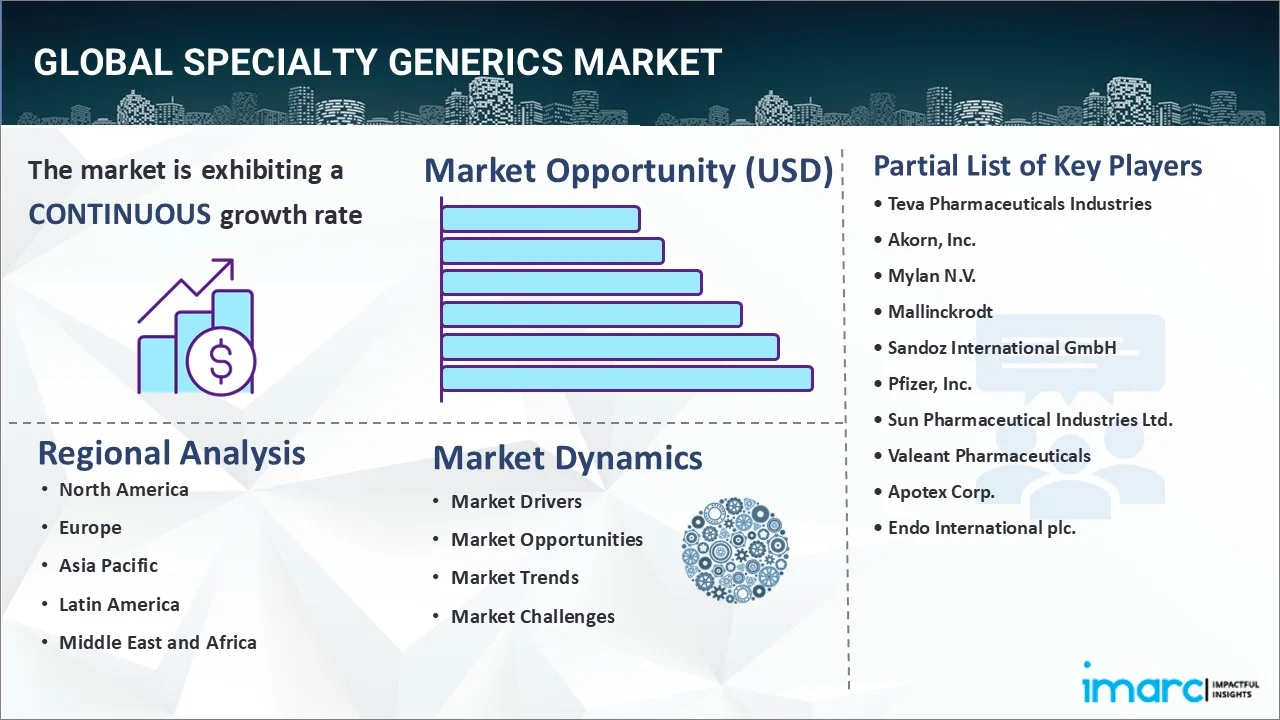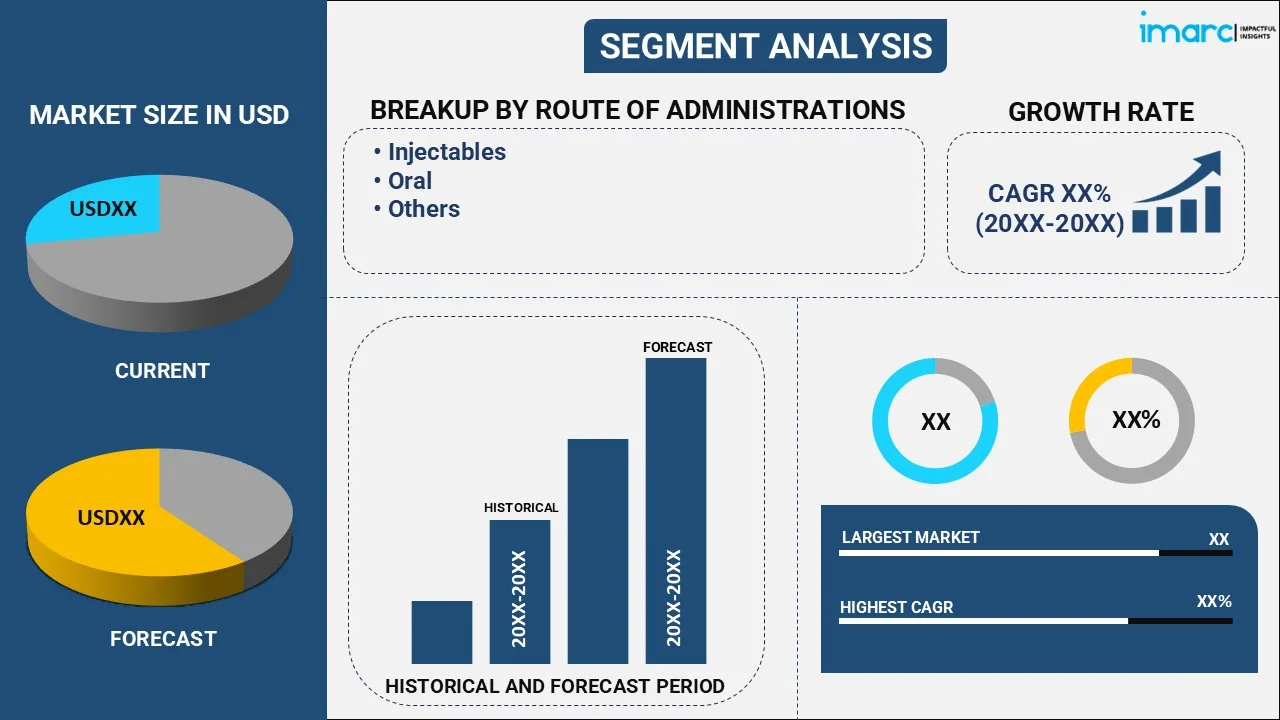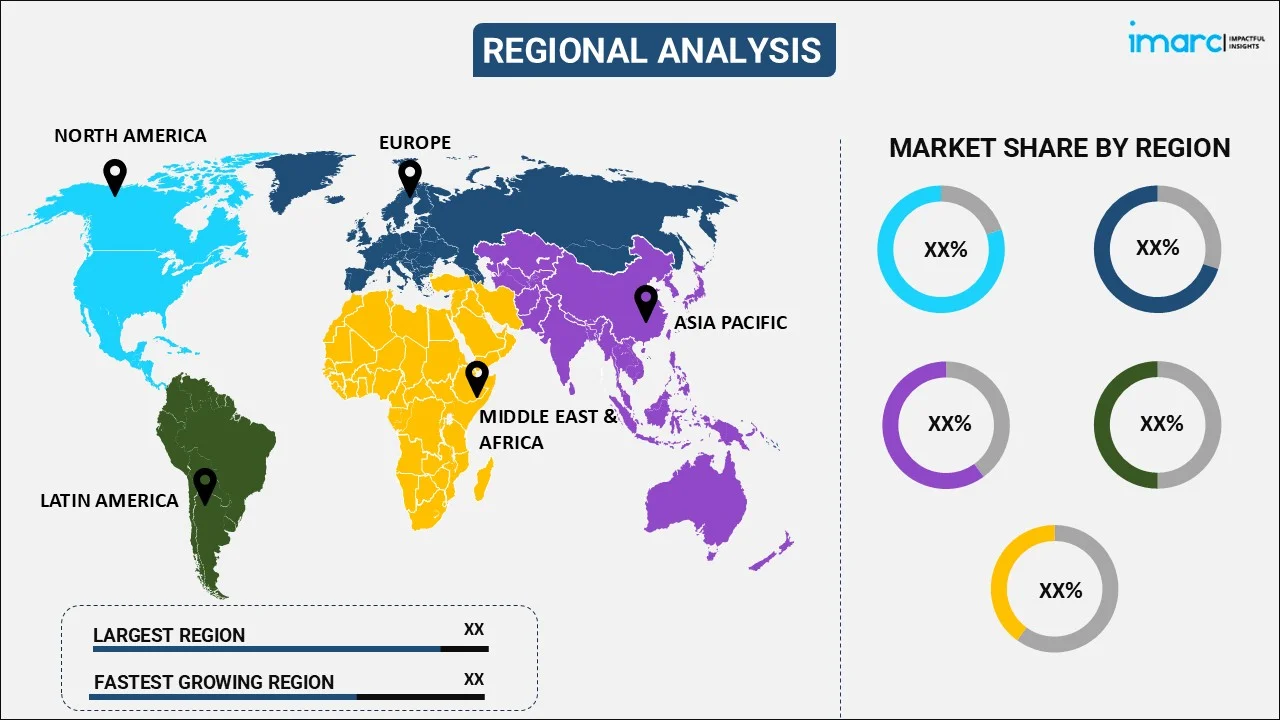
Specialty Generics Market Report by Route of Administration (Injectables, Oral, and Others), Indication (Oncology, Autoimmune Diseases, Infectious Diseases, and Others), Distribution channel (Retail Pharmacies, Specialty Pharmacies, Hospital Pharmacies), and Region 2025-2033
Specialty Generics Market Overview:
The global specialty generics market size reached USD 81.8 Billion in 2024. Looking forward, IMARC Group expects the market to reach USD 178.6 Billion by 2033, exhibiting a growth rate (CAGR) of 9.1% during 2025-2033. There are various factors that are driving the market, which include rising number of strategic collaborations aiming to leverage the capabilities, resources, and market presence, the evolution of online pharmacies and telemedicine platforms, and favorable government initiatives.
|
Report Attribute
|
Key Statistics
|
|---|---|
|
Base Year
|
2024 |
|
Forecast Years
|
2025-2033 |
|
Historical Years
|
2019-2024
|
|
Market Size in 2024
|
USD 81.8 Billion |
|
Market Forecast in 2033
|
USD 178.6 Billion |
|
Market Growth Rate 2025-2033
|
9.1% |
Specialty Generics Market Analysis:
- Major Market Drivers: One of the key market drivers include regulatory incentives. Moreover, there is an increase in the need for wide access to medications, which is acting as a growth-inducing factor.
- Key Market Trends: The rising demand for affordable healthcare solutions and technological advancements in drug development are the main trends in the market.
- Geographical Trends: As per the report, Asia Pacific exhibits a clear dominance, accounting for the biggest market share due to the increasing need to dissipate heat and maintain operational efficiency, coupled with the thriving power generation sector.
- Competitive Landscape: Several players in the specialty generics industry include Teva Pharmaceuticals Industries, Akorn, Inc., Mylan N.V., Mallinckrodt, Sandoz International GmbH, Pfizer, Inc., Sun Pharmaceutical Industries Ltd., Valeant Pharmaceuticals, Apotex Corp., Endo International plc., among many others.
- Challenges and Opportunities: The market poses risks like obtaining regulatory approval for these drugs, along with complex manufacturing processes. Nonetheless, the development of biosimilars allows manufacturers to enter the biologics market and offer more affordable alternatives to expensive biologic therapies and various strategic partnerships and collaborations represent key opportunities in the market.

Specialty Generics Market Trends:
Increasing Demand for Affordable Healthcare Solutions
The growing demand for affordable healthcare solutions due to the rising population, along with the burden of non-communicable diseases (NCDs) among the masses across the globe, is influencing the market positively. Specialty generics, which are bioequivalent versions of brand-name drugs, provide patients and healthcare systems the therapeutic efficacy of innovative medicines but at a reduced cost. In line with this, aging populations in various countries are leading to an increasing incidence of chronic diseases like cardiovascular, diabetes, and arthritis, which is offering a positive specialty generics market outlook. These conditions often require prolonged and complex treatment regimens. The number of persons aged 80 years or older is anticipated to triple between 2020 and 2050 to reach 426 million as per the World Health Organization (WHO).
Patent Expirations of Branded Drugs
One of the most significant drivers of the specialty generics industry is the expiration of patents for branded drugs. When patents expire, it opens the opportunity for other manufacturers to produce and market generic versions of those medications. The research and development (R&D) costs for generics are usually lower than novel drugs and provide enhanced therapeutic efficacy. Each year, drugs with billions of dollars in annual sales lose patent protection. This gives manufacturers a chance to enter well-established markets, which increases specialty generics demand. In addition, leading market participants are launching more effective generic versions of existing drugs. For example, Hikma Pharmaceuticals PLC introduced an approved generic version of the prescription drug Xyrem sodium oxybate for the treatment of narcolepsy in the United States on January 3 2023. The pharmaceutical business based in London announced that its version, which is based on Jazz Pharmaceuticals' Xyrem oral solution CIII, will be used to treat symptoms of cataplexy, or abrupt onset of weak or paralyzed muscles, and excessive daytime sleepiness.
Technological Advancements in Drug Development
Innovations in drug development and manufacturing are enabling the production of more complex generics such as biosimilars, which were previously challenging to produce. The research and development (R&D) process is becoming more efficient by tools like artificial intelligence (AI) and sophisticated analytical techniques, which is bolstering the specialty generics market growth. This allows manufacturers to address a broader range of diseases and conditions than ever before. Furthermore, advancements in manufacturing techniques guarantee that these medications are created with a constant quality and satisfy the exacting requirements established by regulatory agencies. Sandoz, a leading manufacturer of generic and biosimilar pharmaceuticals worldwide stated on July 20 2023 that it will invest over US$ 90 million at its location in Ljubljana, Slovenia, to create a dedicated Sandoz Biopharma Development Center by 2026.
Specialty Generics Market Segmentation:
IMARC Group provides an analysis of the key trends in each segment of the market, along with specialty generics market forecast at the global, regional, and country levels for 2025-2033. Our report has categorized the market based on route of administration, indication, and distribution channel.
Breakup by Route of Administration:

- Injectables
- Oral
- Others
Injectables account for the majority of the market share
The report has provided a detailed breakup and analysis of the market based on the route of administration. This includes injectables, oral, and others. According to the report, injectables represented the largest segment.
Using injectables to administer medication has several benefits such as accurate dosage and quick beginning of action, which makes them appropriate for treating serious medical diseases. Furthermore, the expiration of patents for certain branded biologics and specialty drugs is encouraging generic producers to enter the market with more affordable options. Moreover, the rising focus on R&D activities in the pharmaceutical sector are leading to innovative injectable products with improved therapeutic outcomes.
Breakup by Indication:
- Oncology
- Autoimmune Diseases
- Infectious Diseases
- Others
Oncology holds the largest share of the industry
A detailed breakup and analysis of the market based on the indication have also been provided in the report. This includes oncology, autoimmune diseases, infectious diseases, and others. According to the report, oncology represented the largest segment.
Globally, the prevalence of cancer is increasing, which means there is a continuing need for oncology treatments that are both affordable and effective. The availability and affordability of specialty generics is becoming critical for enhancing cancer care as more patients need long-term therapies. Furthermore, the expiration of patents for several branded oncology drugs opens opportunities for generic manufacturers to enter the market, offering more affordable alternatives without compromising on quality. In addition, new medication delivery methods and formulations as a result of technological developments assist in improving the effectiveness and patient compliance of oncology generics. Moreover, favorable government initiatives are promoting generic drug usage. As per the National Cancer Institute, by 2040, the number of new cancer cases per year is expected to increase to 29.9 Million.
Breakup by Distribution channel:
- Retail Pharmacies
- Specialty Pharmacies
- Hospital Pharmacies
Retail pharmacies represent the leading market segment
The report has provided a detailed breakup and analysis of the market based on the distribution channel. This includes retail pharmacies, specialty pharmacies, and hospital pharmacies. According to the report, retail pharmacies represented the largest segment.
A larger patient population is served by the retail pharmacies, which guarantee the easy and accessible distribution of specialty generic pharmaceuticals. As these pharmacies are typically located in various communities and neighborhoods, patients can easily access their prescribed medications without the need for specialized healthcare facilities. Furthermore, the increasing occurrence of chronic illnesses is catalyzing the demand for long-term care alternatives. In addition, the retail pharmacies' pre-existing connections with healthcare practitioners facilitate easier communication and teamwork, which improves patient care. Retail pharmacies are likely to play an increasingly important role in patient support and distribution as the demand for specialized generics grows.
Breakup by Region:

- North America
- United States
- Canada
- Europe
- Italy
- Germany
- Spain
- United Kingdom
- France
- Asia-Pacific
- China
- India
- Japan
- South Korea
- Latin America
- Brazil
- Mexico
- Middle East and Africa
North America leads the market, accounting for the largest specialty generics market share
The report has also provided a comprehensive analysis of all the major regional markets, which include North America (the United States and Canada); Europe (Italy, Germany, Spain, the United Kingdom, and France); Asia Pacific (China, India, Japan, and South Korea); Latin America (Brazil and Mexico); and the Middle East and Africa. According to the report, North America represents the largest regional market for specialty generics.
The increasing prevalence of chronic diseases and complex medical conditions among individuals in the North America region is bolstering the market growth. Specialty generics, with their cost-effective alternatives to branded specialty drugs are gaining popularity in managing these conditions effectively. Additionally, the expiration of patents for certain branded specialty medications allows key players to enter the market, providing patients with more affordable treatment options. In addition, favorable government policies and initiatives aimed at promoting the use of generic medications are impelling the market growth. These policies are leading to enhanced patient access and overall cost savings in the healthcare system. Moreover, advancements in R&D are leading to the introduction of innovative specialty generics with improved therapeutic outcomes, representing specialty generics market recent opportunities in the region. On 16 April 2024, Alvotech and Teva Pharmaceuticals, a U.S. affiliate of Teva Pharmaceutical Industries Ltd., announced that the U.S. Food and Drug Administration (FDA) approved SELARSDI (ustekinumab-aekn) injection for subcutaneous use, as a biosimilar to Stelara, for the treatment of moderate to severe plaque psoriasis and for active psoriatic arthritis in adults and pediatric patients 6 years and older. Under the strategic partnership between Teva and Alvotech, Teva is responsible for the exclusive commercialization of SELARSDI in the United States.
Competitive Landscape:
- The market research report has also provided a comprehensive analysis of the competitive landscape in the market. Detailed profiles of all major companies have also been provided. Some of the major market players in the specialty generics industry include Teva Pharmaceuticals Industries, Akorn, Inc., Mylan N.V., Mallinckrodt, Sandoz International GmbH, Pfizer, Inc., Sun Pharmaceutical Industries Ltd., Valeant Pharmaceuticals, Apotex Corp., and Endo International plc.
(Please note that this is only a partial list of the key players, and the complete list is provided in the report.)
- Top players are developing innovative formulations, drug delivery systems, and combination therapies to improve efficacy and patient compliance and increase their specialty generics market revenue. Ensuring compliance with regulatory standards and obtaining necessary approvals from health authorities in various countries is a critical aspect for specialty generic companies to launch and market their products. Along with this, the expansion of product portfolios to cover a wider range of therapeutic areas such as oncology, immunology, and rare diseases, to cater to diverse patient needs is impelling the market growth. Apart from this, companies are offering patient support programs that provide counseling, adherence assistance, and financial aid to patients, thereby improving patient outcomes and medication adherence. Furthermore, collaborations with pharmaceutical companies, research institutions, and healthcare organizations allow companies to access new technologies. On 3 April 2023, Endo International plc announced that one of its operating companies, Par Pharmaceutical, Inc., begun shipping the authorized generic (AG) version of Merck's Noxafil® (posaconazole) 200 mg/5 mL oral suspension in the U.S. This newly available Noxafil® AG dosage form is the latest addition to the generics portfolio of the company that provides patient access to high-quality and lower-cost treatment options.
Specialty Generics Market Recent Developments:
- 3 July 2023: Amneal Pharmaceuticals, Inc. launched its authorized generic for Xyrem®1 (Sodium Oxybate) oral solution CIII in the United States. Sodium Oxybate oral solution, 0.5 g/mL is a central nervous system depressant indicated for the treatment of cataplexy or excessive daytime sleepiness (EDS) in patients 7 years of age and older with narcolepsy. In addition, the Company announced it received Abbreviated New Drug Application (ANDA) approvals from the U.S. Food and Drug Administration (FDA) for 5 complex generics products.
- 11 January 2023, Sun Pharmaceutical Industries Limited announced that one of its wholly owned subsidiaries launched a novel anti-cancer drug, Palbociclib in India for patients who have advanced breast cancer, the most common cancer among women in the country. The company will make the drug available under the brand name, PALENOTM (Palbociclib) 75 mg, 100 mg, 125 mg. PALENOTM is the branded generic version of the innovator product that is available at an affordable price.
Specialty Generics Market Report Scope:
| Report Features | Details |
|---|---|
| Base Year of the Analysis | 2024 |
| Historical Period | 2019-2024 |
| Forecast Period | 2025-2033 |
| Units | Billion USD |
| Scope of the Report | Exploration of Historical Trends and Market Outlook, Industry Catalysts and Challenges, Segment-Wise Historical and Future Market Assessment:
|
| Route of Administrations Covered | Injectables, Oral, Others |
| Indications Covered | Oncology, Autoimmune Diseases, Infectious Diseases, Others |
| Distribution Channels Covered | Retail Pharmacies, Specialty Pharmacies, Hospital Pharmacies |
| Regions Covered | Asia Pacific, Europe, North America, Latin America, Middle East and Africa |
| Countries Covered | United States, Canada, Germany, France, United Kingdom, Italy, Spain, China, Japan, India, South Korea, Brazil, Mexico |
| Companies Covered | Teva Pharmaceuticals Industries, Akorn, Inc., Mylan N.V., Mallinckrodt, Sandoz International GmbH, Pfizer, Inc., Sun Pharmaceutical Industries Ltd., Valeant Pharmaceuticals, Apotex Corp., Endo International plc., etc. |
| Customization Scope | 10% Free Customization |
| Post-Sale Analyst Support | 10-12 Weeks |
| Delivery Format | PDF and Excel through Email (We can also provide the editable version of the report in PPT/Word format on special request) |
Key Benefits for Stakeholders:
- IMARC’s industry report offers a comprehensive quantitative analysis of various market segments, historical and current market trends, market forecasts, and dynamics of the market from 2019-2033.
- The research report provides the latest information on the market drivers, challenges, and opportunities in the global market.
- The study maps the leading, as well as the fastest-growing, regional markets. It further enables stakeholders to identify the key country-level markets within each region.
- Porter's five forces analysis assists stakeholders in assessing the impact of new entrants, competitive rivalry, supplier power, buyer power, and the threat of substitution. It helps stakeholders to analyze the level of competition within the specialty generics industry and its attractiveness.
- The competitive landscape allows stakeholders to understand their competitive environment and provides insight into the current positions of key specialty generics companies.
Key Questions Answered in This Report
The global specialty generics market was valued at USD 81.8 Billion in 2024.
The increasing prevalence of numerous life-threatening diseases, such as cancer, multiple sclerosis, HIV, etc., is primarily catalyzing the global specialty generics market.
Sudden outbreak of the COVID-19 pandemic had led to the implementation of stringent lockdown regulations across several nations resulting in delayed R&D activities pertaining to specialty generics.
Based on the route of administration, the global specialty generics market can be segregated into injectables, oral, and others. Among these, injectables hold the majority of the total market share.
Based on the indication, the global specialty generics market has been bifurcated into oncology, autoimmune diseases, infectious diseases, and others. Currently, oncology diseases exhibit a clear dominance in the market.
Based on the distribution channel, the global specialty generics market can be categorized into retail pharmacies, specialty pharmacies, and hospital pharmacies. Among these, retail pharmacies currently account for the majority of the total market share.
On a regional level, the market has been classified into North America, Europe, Asia Pacific, Middle East and Africa, and Latin America, where North America dominates the global market.
Some of the major players in the global specialty generics market include Teva Pharmaceuticals Industries, Akorn, Inc., Mylan N.V., Mallinckrodt, Sandoz International GmbH, Pfizer, Inc., Sun Pharmaceutical Industries Ltd., Valeant Pharmaceuticals, Apotex Corp., Endo International plc.
Need more help?
- Speak to our experienced analysts for insights on the current market scenarios.
- Include additional segments and countries to customize the report as per your requirement.
- Gain an unparalleled competitive advantage in your domain by understanding how to utilize the report and positively impacting your operations and revenue.
- For further assistance, please connect with our analysts.
 Inquire Before Buying
Inquire Before Buying
 Speak to an Analyst
Speak to an Analyst
 Request Brochure
Request Brochure
 Request Customization
Request Customization




.webp)




.webp)












